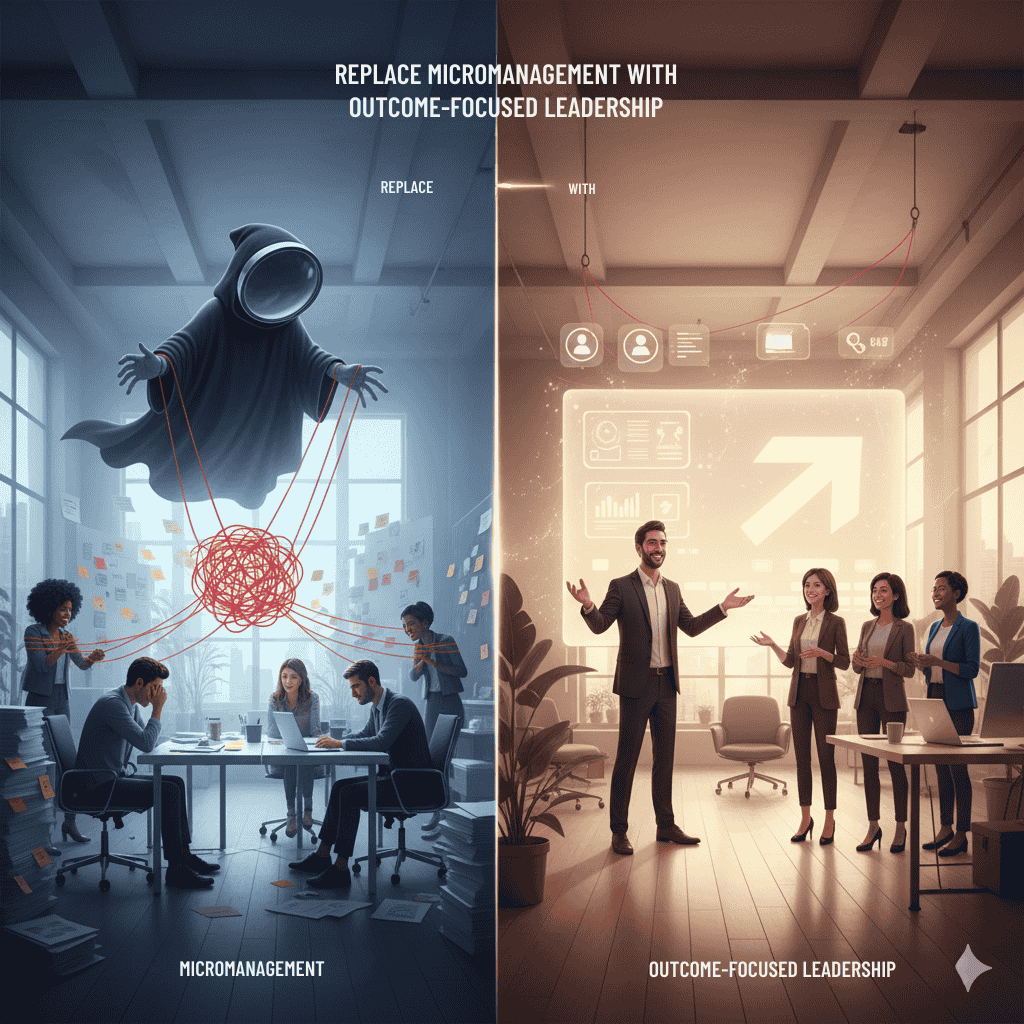7 Leadership Changes That, Research Shows, Improve Retention
The research-backed guide to eliminating the management behaviors that drive away your best people
The Problem Is Clear: Manager behavior is the primary driver of employee turnover in modern organizations. The research consistently shows that 57% of employees leave jobs specifically because of their boss, while 82% would consider quitting due to poor management. When "toxic work environment" ranks as the #1 reason people quit—a condition directly tied to management practices—the solution becomes clear.
What You Can Do: These are seven specific behavioral changes, each backed by multiple research studies, that measurably improve employee retention. In all, it’s based on data from over 100,000 employees across multiple industries that I found during my deep dive into this topic.
Ai generated photo
7 Practices Every Manager Must Master
1. Implement Individualized Management Approaches
What's Happening: Different personality types and work styles require different management approaches. Research in organizational psychology demonstrates that "one-size-fits-all" management fails because it ignores fundamental cognitive and motivational differences between individuals.
Why This Matters: Studies show that managers who adapt their leadership style to individual employee needs see 67% higher employee engagement and 40% lower turnover rates.
How To Do It:
Create individualized communication and feedback plans for each employee
Don’t overthink it though. It’s not a different approach for everyone, more like having 3-4 approaches and knowing which one is best for which member of your team.
Document for yourself each team member's preferences
Adjust your check-in frequency, autonomy levels, and communication styles accordingly
Results You’ll See: Teams with individualized management approaches show 23% higher retention rates within the first year.
Test Yourself: Use AI to help you learn how to customize your communications with each of your team members.
(This uses “projects” feature in ChatGPT, Claude, or another AI. It may be a free or paid feature, depending on the AI platform used. If you’re not sure what the “projects” feature is, here’s an intro video I found that’s pretty good.)
Create a “Project” for one of your team members. (Example: “Comms with Jim”)
Upload these 2-3 things into the project as “files” (supporting documentation and information).
Your own Brain Dump about Jim’s style - Write a big list of bulleted notes with everything you can think of when you think of how you can or should communicate with Jim most effectively. Could be short, could be long, doesn’t matter, you’re just getting it out of your head and into the AI Project for context.
10-20 email chains with Jim - You want to provide more context around Jim’s style when he communicates. It’s especially helpful if some of these are email chains with 2-3 responses from Jim in a row.
Jim’s personality assessment (if available) - If you have these, maybe it’s his DISC profile or whatever personality test your workplace might have for Jim’s work and communication style.
Now, TRY TAILORING YOUR COMMS WITH IT - The next time you’re going to send an email/chat to Jim:
write your message to Jim (but don’t send)
Select All the text (include the previous emails if it’s a reply to a chain of emails).
“Copy” all the text.
start a new chat in your “Comms With Jim” project in AI
Type “how would you tailor this communication to be better received by Jim based on his style?” and then “Paste” your text.
How much did it change what you wrote?
2. Establish A System To Ensure Expectations Are Communicated
What's Happening: Ambiguity creates psychological stress and decision fatigue. When employees must guess at expectations, cortisol levels increase, leading to burnout and disengagement.
Why This Matters: Gallup research reveals that employees who strongly agree they know what's expected of them are 2.5 times more likely to be engaged. Organizations with clear expectations see 25% lower turnover.
How To Do It:
Document all processes, standards, and quality measures in writing
(if you don’t have these, ask the people doing the process to create an initial draft of one, and collaborate on creating these. This doesn’t have to be something YOU do, but it’s something you need.)Have an expectation-setting meeting within the first 30 days of someone joining your team.
Implement regular check-ins for all team members at an ideal interval for each team member.
(see #1 above, not everyone will be “weekly.” Some might prefer “monthly” or “every other week”.)
Results You’ll See: Clear expectations reduce new employee turnover by 33% in the first 90 days.
3. Replace Micromanagement with Outcome-Focused Leadership
Ai generated photo
What's Happening: Self-Determination Theory proves that autonomy is one of three fundamental psychological needs. When managers control process rather than focusing on outcomes, they violate this basic need, triggering turnover behaviors.
Why This Matters: Harvard Business Review research shows that micromanaged employees are 68% more likely to consider leaving their jobs. Conversely, teams with high autonomy show 76% higher job satisfaction.
How To Do It:
“Begin with the end in mind” - When you assign work, communicate clearly what results you’re looking for and when.
Implement milestone-based check-ins rather than daily oversight. Measure results weekly, processes monthly (not daily)
Create decision-making frameworks that allow people to make their own decisions, specify when approval is needed, but strive to empower people to make their own decisions (within the guard rails you set)
Results You’ll See: Outcome-focused management reduces turnover by 31% and increases productivity by 19%.
4. Optimize Meeting Efficiency Using Time-Value Analysis
What's Happening: Attention residue theory demonstrates that frequent meeting interruptions reduce cognitive performance by up to 40%. Each context switch requires 23 minutes to fully refocus.
Why This Matters: Research shows that 67% of senior managers report spending too much time in meetings, while employees cite "too many meetings" as a primary job dissatisfactor. Studies indicate that inefficient meetings cost organizations $37 billion annually in lost productivity.
How To Do It:
Apply the "collaboration requirement test": only meet when live discussion adds value
Implement a requirement that all meetings have a stated Agenda and Purpose.
Results You’ll See: Optimized meeting practices increase team productivity by 26% and job satisfaction by 14%.
Want more on this: I did a podcast episode with 28 tips. This will be huge for your team. Dive in!
Ai generated photo
5. Establish Boundary-Respecting Communication Standards
What's Happening: Chronic activation of stress response systems through “always-on communication expectations” leads to burnout and increased turnover.
Why This Matters: Research shows that employees who feel their work-life balance is respected are 21% more productive and 38% more likely to recommend their company as a great place to work. Off-hours communication increases turnover risk by 25%.
How To Do It:
Define "emergency" criteria for after-hours communication
Use delayed-send or “schedule send” email features so emails do not arrive outside normal work hours. I’m not saying you can’t work on email while you’re thinking about it, but SCHEDULE the delivery so it doesn’t hit the person’s inbox until the next business morning.
Clarify response-time expectations (This is often included in a team communication protocol. I did a podcast episode on Team Communication Protocols, and wrote a blog post with a template you can copy.)
Model and respect boundary-setting behavior consistently
Results You’ll See: Boundary-respecting managers see 29% lower burnout rates and 22% higher employee retention.
6. Come Through on your Commitments - Use a system to track And deliver on them
What's Happening: Psychological safety research demonstrates that predictable, reliable leadership behaviors reduce stress hormones and increase engagement neurochemicals like oxytocin and dopamine.
Why This Matters: Trust is the foundation of employee engagement, and reliability directly builds trust. Research shows that managers who consistently follow through see 41% lower absenteeism and 24% higher profitability on their teams.
How To Do It:
Do you have a system for this? Use a system to track anything you tell a team member you’ll do. (Here’s a blog post on the importance of keeping lists, and another on to-do list tips, which are 2 of the biggest parts of the system you should have).
Create a mutual environment where your team feels as comfortable holding you accountable as you do with them.
Acknowledge both when you complete something a team member was waiting on from you, and when they deliver something you were waiting on from them.
Results You’ll See: Reliable follow-through increases team trust scores by 34% and reduces voluntary turnover by 28%.
7. Conduct Structured Career Development Conversations
What's Happening: Social Exchange Theory explains that employees who perceive investment in their future reciprocate with loyalty and higher performance. Regular development conversations signal this investment.
Why This Matters: Gallup research shows that 87% of millennials rate career development as important, and employees who receive regular development conversations are 15% more engaged. Most critically: 42% of turnover is preventable through manager intervention.
How To Do It:
Schedule regular career development discussions separate from performance reviews or regular bi-weekly check-ins, quarterly is a good frequency target, though they could be as frequently as monthly, depending on the employee and situation.
These should have stated agendas. Use structured conversation frameworks: goals, barriers, next steps, timeline. It should feel like you’re tracking their progress and helping them in their development journey.
(Don’t just ask “so what do you want to do for your development?”)Create individual development plans with specific skills and timeline targets. Not to enforce them as a performance criteria in their job, but because having a plan and specific actions and next steps will greatly increase the likelihood that they’ll make progress.
Track career progression. This way you can both see the progress. Be excited about it.
Results You’ll See: Regular development conversations reduce turnover by 37% and increase internal promotion rates by 43%.
The High-Impact Starting Point
Feeling overwhelmed by seven major behavioral changes? Not sure where to start? Start with these three practices, in order:
Start with explicit expectation-setting (#2 above) which provides the foundation for everything else—you can't manage what isn't clearly defined.
Implement a tracking systems for your commitments to team members (#6 above) create immediate trust-building wins that amplify every other improvement.
Structured career conversations (#7 above) generate the highest employee loyalty returns and prevent most preventable turnover.
The Compound Effect of Better Leadership
Managers who implement multiple retention practices experience exponentially better team performance. Research shows that managers with strong people-development skills see 4x higher employee engagement, while organizations investing in manager development retain 94% more employees long-term.
Performance-based leadership increasingly separates great managers from good ones. Data analysis of management effectiveness reveals that managers who complete leadership development programs increase team productivity by 23%, while those with cross-functional management experience boost team retention by 35%.
Organizations with strong coaching cultures generate 51% higher revenue and create advancement opportunities for retention-focused managers with 62% higher engagement scores.
Understanding the Generational Management Shift
Podcast Episode: Which of Your Bad Productivity Habits Are Driving Away Your Best Employees, and How to Fix That
Knowing what to change is only half the battle. Understanding why these changes work is what makes them stick. In my conversation with retention expert Cara Silletto, she revealed some of the deeper dynamics around why these seven practices are so effective in today's workplace.
The Generational Context That Changes Everything
Cara's "generational lens" explains why management practices that worked decades ago now drive people away. She traced how societal changes—from latchkey kids of the 1970s to the "stranger danger" era of the 1980s—fundamentally altered workplace expectations.
Gen X grew up solving problems independently from age 8, leading to "sink or swim" workplace cultures. But Millennials and Gen Z were raised with more structured support, creating different needs for guidance and communication. This isn't about being "lazy". It's about different developmental experiences creating different workplace requirements.
The Employee Retention Ecosystem
Cara developed what she calls the "Employee Retention Ecosystem." A systematic approach that treats every employee like a different type of houseplant. Some employees are, for example, like "orchids" who need frequent, delicate attention and regular check-ins. Others are "cacti" who thrive with minimal oversight and monthly touchpoints.
The key insight: employees can shift between these categories based on life circumstances, stress levels, or role changes. Effective managers regularly assess and adjust their approach rather than assuming someone's support needs remain constant.
If this post is speaking to you, dive into that episode, I think it will really resonate for you.
The Bottom Line
This isn't about becoming a "nicer" manager. It's about implementing practices that create measurable results. Each of these seven changes has been validated through research and real-world applications.
Manager behavior is the primary controllable factor in employee retention. By implementing these practices, you don't just reduce turnover, you create a high-performance environment where talented people choose to stay, grow, and contribute their best work.
The question isn't whether these practices work. The research, and my own experience, shows they do. The question is whether you'll implement them before your best people make the decision for you.
References & Further Reading
DDI (2019). Frontline Leader Project – New Research on Why Employees Quit Their Bosses. PR Newswire. https://www.prnewswire.com/news-releases/horrible-bosses-new-research-reveals-why-employees-quit-their-jobs-301234567.html
Korolevich, S. (2022). Horrible Bosses: Are American Workers Quitting Their Jobs Or Quitting Their Managers? GoodHire Survey Report. https://www.goodhire.com/resources/horrible-bosses-survey
Tatel, C., & Wigert, B. (2024). 42% of Employee Turnover Is Preventable but Often Ignored. Gallup Workplace. https://www.gallup.com/workplace/247391/fixable-problem-costs-businesses-trillion.aspx
Pendell, R., & Vander Helm, S. (2022). Generation Disconnected: Data on Gen Z in the Workplace. Gallup. https://www.gallup.com/workplace/195803/why-millennials-job-hopping.aspx
SHRM (2023). Future of Talent Retention Report – Why Employees Leave. Society for Human Resource Management. https://www.shrm.org/about-shrm/press-room/press-releases/pages/toxic-workplace-culture-report-2023.aspx
Rogelberg, S. G., et al. (2019). The Science and Fiction of Meetings. Harvard Business Review. https://hbr.org/2017/07/stop-the-meeting-madness
Gallup (2023). State of the Manager Report. https://www.gallup.com/workplace/231593/why-great-managers-rare.aspx
I’m Brian. At age 4, I was diagnosed with insulin dependent (type 1) diabetes and told that my life was going to be 10-20 years shorter than everyone else. As a kid I took time for granted, but now as an adult, time is the most precious thing that I have. After spending a career hands-on in the trenches as a leader at all levels, I now train Productivity Gladiators to level up their careers. Graduates wield superpowers in time management, practical leadership, communication, & productivity. If what you’ve seen here intrigues you, reach out, let’s chat!
“Time is the currency of your life, spend it wisely.”




